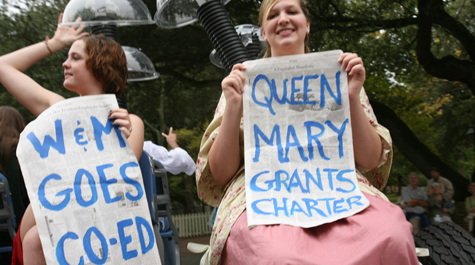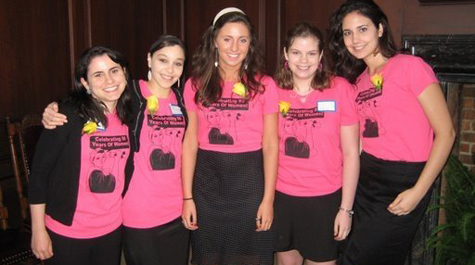W&M celebrates 90 years of coeducation
"After many controversies and much worry this summer, I decided to come to Wm. and Mary, this first year of its coeducation," she wrote in her diary. "I do not now regret my choice."
Now, nearly a century since Barksdale and 23 others made that choice, the College is celebrating those first women and the thousands who followed their footsteps through William & Mary over the past 90 years.
History
Due to World War I, enrollment at the College in the early 20th century had dropped drastically. This decline led the College to its decision to admit women students, said Carolyn Whittenburg, the director of the National Institute of American History and Democracy who received her doctorate in education from William & Mary.
The College enrolled its first 24 women in 1918. By the 1919-1920 school year, the College had increased its enrollment to 333 students, 100 of whom were women. In 1925-1926, when the enrollment grew to more than 1,000, there were more than 450 women students at William & Mary.
"I always say that women actually saved William & Mary," said Whittenburg. "In 1931-1932 the student enrollment totaled 1,682 students which included just over 800 women. The following year, 1932-1933, women students outnumbered the men students for the first time in the history of William and Mary. Coeducation made a tremendous impact here at the College."
Whittenburg said that two William & Mary president played a large role in bringing women to the College: Lyon G. Tyler initiated coeducation at the College in 1918, and J.A.C. Chandler "brought a great transformation to William & Mary during his presidency from 1919 to 1934."
"President Chandler's dream was to modernize the College and make it a leader in higher education," she said. "He therefore increased enrollment drastically. Enrollment in 1918-1919 was only just over 130 students. When enrollment topped more than 1,600 in the early 1930s, Chandler realized his dream. With the continual growth of women students as well as men students, Chandler transformed the tiny College into a modern institution with a new emphasis on educational and professional career training."
Whittenburg did her William & Mary doctoral dissertation on Chandler, his transformation and the first women faculty.
"He made William and Mary a leader in the state of Virginia as a great public institution offering a liberal arts education equally to women as well as to men," she said.
Today, about 3,000 undergraduates at William & Mary are women, and thousands of women from all over the country and world call William & Mary their alma mater. Some of the College's most notable alumnae include: Linda Lavin ('59), an renowned theater and television actress; Rebecca Beach Smith ('71, J.D. '79), judge with the U. S. District Court for the Eastern District of Virginia; Carolyn "Biddy" Martin ('73), chancellor of the University of Wisconsin-Madison; Glenn Close ('74), an award-winning actress; Janet A. Sanderson ('77), U.S. Ambassador to Haiti; Christina Romer ('81) director of the Council of Economic Advisers; and Beth Comstock ('82), chief marketing officer and senior vice president of GE.
Some of the women who graduated from William & Mary now even hold top positions at the College. For instance, Karen Cottrell ('66, M.Ed. '69, Ed.D. '84) is the executive director of the Alumni Association. Additionally, Ginger Ambler, who is now the interim Vice President for Student Affairs at William & Mary, graduated from the College with a B.A. in English in 1988 and a Doctor of Philosophy in Educational Policy, Planning and Leadership in 2006. Also, Virginia McLaughlin, the dean of the School of Education, received her undergraduate degree in psychology from the College in 1971.
In September 2008, William & Mary's newest female students were welcomed to the College by alumna and JP Morgan executive Rhian Horgan ('99). Her Opening Convocation speech on "opening doors" was especially meaningful for the ceremony as it officially kicked off the 90th year of women at William & Mary.
"Today the College opens its doors to you, granting you the opportunity to pursue any path you choose," Horgan said at the ceremony. "I encouraged and challenge you during your time at the College and later as alumni to not only walk through the doors which will be opened for you, but also to then open doors wherever possible."
Recognition
Several groups have engaged in special projects throughout the year to recognize and explore the history of women at the College.
The Swem Library's Special Collections Research Center created a blog to chronicle the first year of women at the College. The blog, entitled "Mary Comes to the College with William," contains photos, excerpts from letters, newspaper clippings, government documents and references to various other resources to paint a complete portrait of that first year, from the Board of Visitors endorsement of the legislation on Feb. 12, 1918 to the end of the academic year in June 1919.
"We know this blog will be a great resource for students conducting research into this period of the College's history as well as of interest to students and alumni just interested in learning a bit more about the history of their alma mater," said Amy Schindler, university archivist. "We also hope that William and Mary alumni, faculty, and staff will follow the blog and think about items in their collections at home that they would like to add to the SCRC's collections to share their piece of the College's history from another era with others."
Additionally, during women's history month (March), the SCRC used their Twitter feed to regularly update followers with historical facts about women at the College.
Last fall, during Homecoming weekend, images from the College's yearbook, "The Colonial Echo," were enlarged and set out in a display at the Alumni House to honor the anniversary. Some of those images are currently also available in an exhibit at the Swem Library, titled "There's Something About the Marys." The exhibit, which went up in January, also includes photos, scrapbooks and other materials from the SCRC's collections. It is located in the two flat cases in read and relax area on the first floor of the library, and it will be available until May 2009.
In addition to the aforementioned efforts, the Department of Women's Studies made strides to recognize the anniversary this year. They hosted a slew of special speakers throughout the year, including Virginia Institute of Marine Science alumna Padma Venkatraman. During her visit in October 2008, Venkatraman discussed her work with women in mathematics and how she became a writer. Her talk was framed in the context of the anniversary, said Christy L. Burns, director of Women's Studies.
Women's Studies also hosts an annual lecture in honor of Minnie Braithwaite, a woman who applied to take chemistry classes at William & Mary in 1896. Though she was denied her request, she "went on to live an exciting life," said Burns.
"I told our audience this year that, while it seemed strange perhaps to host a lecture in Braithwaite's name, in preparation for Women's History Month, we like to remember the women who worked hard to open the doors that have since allowed so many women in," said Burns.
This year's Braithwaite lecture, held on Feb. 26, was given by Annelise Orleck, a professor of history at Dartmouth University who has been recognized for her work in "the organizing success of welfare mothers in Las Vegas in the 1960s and 70s."
During Women's History Month, two faculty members in Women's Studies, Suzanne Raitt and Jenny Putzi, hosted "Shakespeare's Sister" Day.
"They claimed a table at the Daily Grind and had interested folks on campus sign up to read from women's writing, in 10 minute increments across the day," said Burns. "Students and faculty read from a range of works. It was delightful!"
Additionally during Women's History Month, the College's Feminist Majority Leadership Alliance hosted a viewing of the film, "Salt of the Earth," with an introduction and Q&A by Women's Studies Professor Leisa Meyer.
Throughout the year, a group of Women's Studies students engaged in an independent study to look at 90 years of women at William & Mary, under the direction of Hilary Marcus, a teaching fellow.
The group created a documentary in which they interview alumnae from various generations, including Virginia Forwood Pate Wetter ('40), Whittenburg, Nancy Johnston ('74), Harriet Condyles ('79) and Kyra Cook ('91). The documentary looks at what life was like for the women at the College during various times in history.
Domino said that meeting with the alumni has taught her that change is possible.
"Look at how far we've come since even 40 years ago," said Junior Cate Domino. "We could actually make a difference in changing the college culture."




















